Cebu is often called the “Queen City of the South,” but do you know what it is famous for? Sunny beaches, Spanish-era landmarks, and a food culture crowned by Cebu lechon.
But what truly makes it stand out is how it brings together history, adventure, and modern city life on one island.
From centuries-old churches that tell stories of Spanish arrival to coral reefs that rival some of the best in Asia, Cebu has ample stories that you must visit to hear.
Unlike many other destinations, Cebu feels easy to navigate for travellers because English is widely spoken here, along with Cebuano and Filipino.
That’s why, whether you’re chatting with a local over a plate of freshly grilled seafood or negotiating for dried mangoes in Carbon Market, you’ll rarely feel lost in translation.
Timing your trip matters, too. The best time to visit is when this island shines brightest in the dry months of December to May.
And if you arrive in January, you’ll witness the Sinulog Festival, a lively street celebration that turns the city into one big parade of music, dance, and faith.
And of course, there’s the food. Cebu lechon isn’t just a dish- it’s an identity of Cebu. Anthony Bourdain once crowned it the “best pig ever,” and tasting it fresh from the fire here is a culinary experience that’s hard to forget.
Beyond the beaches and festivities, Cebu surprises visitors with experiences you won’t expect: a sardine run rivalling South Africa, canyoneering through turquoise cascades, and island getaways where time seems to pause.
Let’s have a quick look at the list of the best things to do in Cebu City
Quick Look at the Top Things to Do in Cebu
|
Overview: Skip the standard Cebu checklist- this isn’t just about whale sharks and beaches. Cebu is a mix of history, adventure, food, and islands that most travellers overlook. Beyond the postcards, you’ll find canyons, centuries-old churches, and underwater spectacles like the sardine run. What makes this city memorable isn’t only what you see, but the stories you live. These unique, handpicked things to do in Cebu will help you see the island in a way few others do.
So, let’s learn about the best things to do in Cebu to include in your Philippines itinerary
Visit Magellan’s Cross and the Basilica del Santo Niño
Magellan’s Cross and the Basilica del Santo Niño are the two important stops in Cebu.
Magellan’s Cross can be considered a landmark because it is a wooden cross planted in 1521 by Portuguese explorer Ferdinand Magellan upon arriving in the Philippines.
Encased in a small chapel, the cross symbolises the introduction of Christianity to the country.
Just a short walk away lies the Basilica Minore del Santo Niño, the oldest Roman Catholic church in the Philippines, dating back to 1565.
Inside, you’ll find the revered statue of the Santo Niño (Holy Child Jesus), a gift from Magellan to Cebu’s Queen Juana. To this day, it remains one of the most important religious icons for Filipinos, drawing millions of devotees during the annual Sinulog Festival.
Things to See Here
- The Encased Cross (The wooden cross)
- Ceiling Murals (Colourful paintings showing the baptism of Cebu’s first Christians)
- Basilica’s Façade (beautiful Baroque and Romanesque architecture)
- The Santo Niño Statue (The revered image of the Child Jesus, a gift from Magellan)
- Museum & Relics (religious artefacts and historical records)
Useful Notes
- Opening Hours: Basilica- 6:00 AM to 8:00 PM daily; Magellan’s Cross is open during the day.
- Entry Fee: Free (donations accepted).
- Location: Osmeña Boulevard, Cebu City (downtown area).
- Recommended Duration: 30 to 45 minutes.
Travel Tip: Visit in the morning to avoid crowds and catch a Mass for a more immersive experience.
Explore Fort San Pedro and Colon Street
Fort San Pedro is a military defence structure built in 1565. Spanish and Cebuano workers constructed it under the command of Miguel López de Legazpi, who was the first Spanish governor in the Philippines.
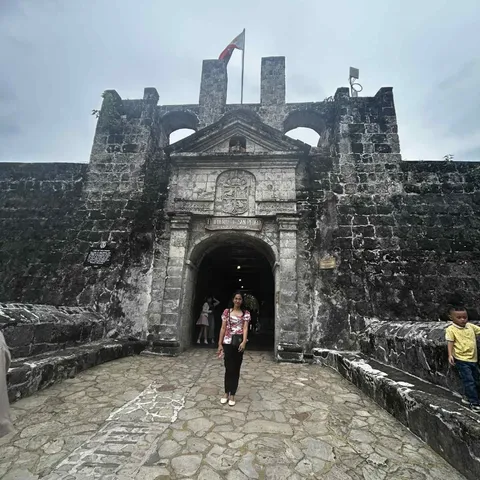
Considered the oldest triangular bastion fort in the country, it once protected the early settlement from pirates and foreign invaders.
Today, it serves as a peaceful historical park where you can wander through stone walls, gardens, and small galleries showcasing Cebu’s past.
Just a short ride away is Colon Street, the oldest street in the Philippines. Named after Christopher Columbus (Cristóbal Colón in Spanish), it was once the centre of trade and commerce in Cebu.
While it has transformed into a busy shopping district, you can still spot old theatres, heritage buildings, and vibrant street life that reflect Cebu’s urban heritage.
Together, Fort San Pedro and Colon Street offer a glimpse into the island’s colonial history and evolving city culture.
Things to See Here
- The Triangular Bastion Walls (the oldest fort structure in the Philippines)
- Fort Museum (exhibits of Spanish-era documents and relics)
- Garden Courtyard (a peaceful spot inside the fort)
- Colon Street Theatres (remnants of Cebu’s old entertainment district)
- Heritage Buildings & Street Markets (mix of old charm and bustling local trade)
Useful Notes
- Opening Hours: Fort San Pedro – 8:00 AM to 7:00 PM daily, Colon Street is open 24 hours.
- Entry Fee: Fort San Pedro – 50 INR for adults, 30 INR for students/seniors, Colon Street – Free.
- Location: Fort San Pedro- A. Pigafetta Street, near Plaza Independencia, Cebu City. Colon Street- Downtown Cebu City.
- Recommended Duration: 1.5 to 2 hours (combined).
Travel Tip: Visit Fort San Pedro in the morning for photos without crowds, then head to Colon Street in the evening for its lively atmosphere.
Try Canyoneering at Kawasan Falls in Badian
Located in Badian, about three hours from Cebu City, canyoneering at Kawasan Falls is one of the most unforgettable adventures in Cebu.
This activity takes you through turquoise rivers, lush canyons, and natural rock formations. The experience combines trekking, swimming, sliding down smooth rocks, and jumping off cliffs into crystal-clear pools.
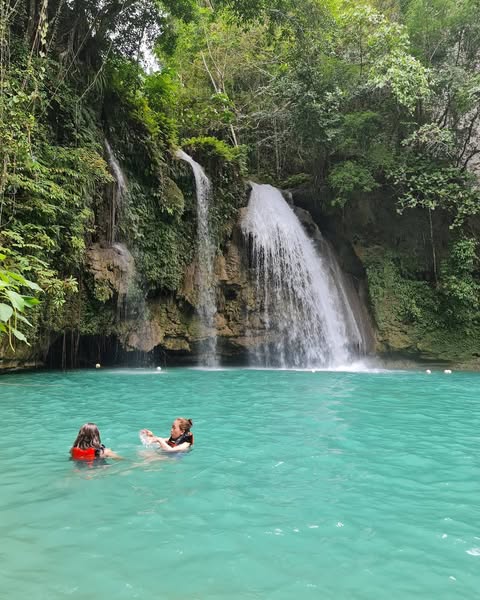
The final stop is the iconic Kawasan Falls, a three-tiered cascade surrounded by lush tropical greenery.
The activity is guided, with safety gear provided, and suitable for both beginners and experienced adventurers. The jumps range from 3 to 10 metres, but you can always skip the higher ones if you’re not comfortable.
You also get a stunning glimpse of Cebu’s natural landscape, making it one of the island’s most talked-about activities.
Things to See Here
- Turquoise Canyon Pools (perfect for swimming and cliff-jumping)
- Natural Water Slides (smooth rocks shaped by the river’s flow)
- Jungle Trails (lush paths leading through Badian’s wilderness)
- Multi-tiered Kawasan Falls (the main highlight with its emerald lagoon)
- Riverside Huts & Picnic Areas (great for relaxing after the adventure)
Useful Notes
- Opening Hours: 6:00 AM to 3:00 PM (canyoneering tours usually start in the morning).
- Entry Fee: Guided tours start around 2330 – 3100 INR per person (including gear, guide, and lunch).
- Location: Badian, Cebu (approximately 3 hours by bus or car from Cebu City).
Travel Tip: Wear aqua shoes for grip, bring a waterproof bag, and start early to avoid the midday rush.
Swim with Whale Sharks in Oslob
One of Cebu’s most popular and debated attractions is swimming with whale sharks in Oslob.
This small coastal town is about 3 to 4 hours south of Cebu City. It is famous for offering people the chance to see gentle giants up close.
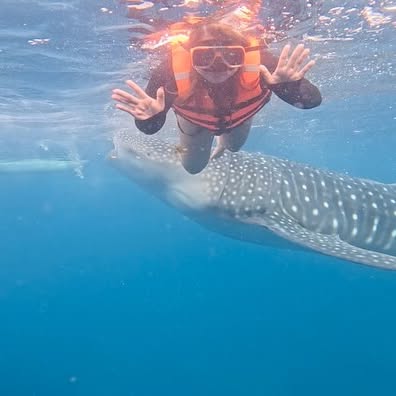
Locally called butanding, whale sharks are the biggest fish in the sea. In Oslob, you can have amazing encounters with them as they swim smoothly through the clear waters.
Local operators manage the activity closely. But visitors must follow strict rules: do not touch anything, do not use flash photography, and keep a safe distance.
Some travellers question the ethics of feeding practices in Oslob. However, Oslob raises awareness of marine conservation and provides income for local communities.
You can snorkel on the surface or dive deeper. Either way, sharing the water with these amazing creatures is an awe-inspiring experience.
Note: Pair it with nearby attractions like Tumalog Falls for a full-day trip.
Things to See Here
- Whale Sharks (up-close encounters in their natural waters)
- Snorkelling & Diving Options (surface viewing or scuba diving)
- Scenic Tan-awan Coast (clear waters with mountain backdrops)
- Local Boats (banca) Ride (traditional wooden canoes used for tours)
- Tumalog Falls (a nearby waterfall often added to the itinerary)
Useful Notes
- Opening Hours: 6:00 AM to 12:00 PM daily (best time is early morning).
- Entry Fee: 800 INR for snorkelling, 2330 INR for scuba diving (includes boat and guide).
- Location: Tan-awan, Oslob, Cebu (about 3.5-4 hours by bus or private car from Cebu City).
Travel Tip: Arrive before 7:00 AM to avoid long queues and ensure sightings. Always respect the guidelines for sustainable interaction.
Discover Tumalog Falls and Sumilon Island
After swimming with whale sharks in Oslob, most travellers head to nearby Tumalog Falls and Sumilon Island for a complete day of nature and relaxation.
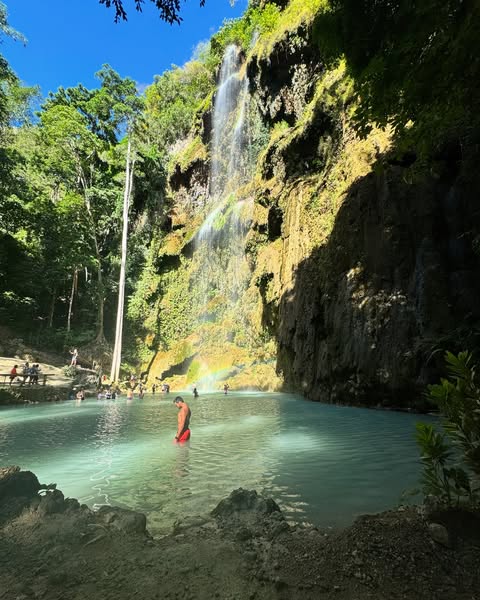
Tumalog Falls, known as the “veil-like falls,” has thin streams of water flowing down a moss-covered cliff, creating a curtain-like effect. It is one of the most beautiful waterfalls in the Philippines.
Its shallow turquoise pool is great for a refreshing swim after a morning of adventure.
Sumilon Island is just a short boat ride away. It is famous for its white sandbar that changes shape with the tides, creating beautiful scenery.
Sumilon Island is known for its marine sanctuary, which is great for snorkelling among colourful fish and corals.
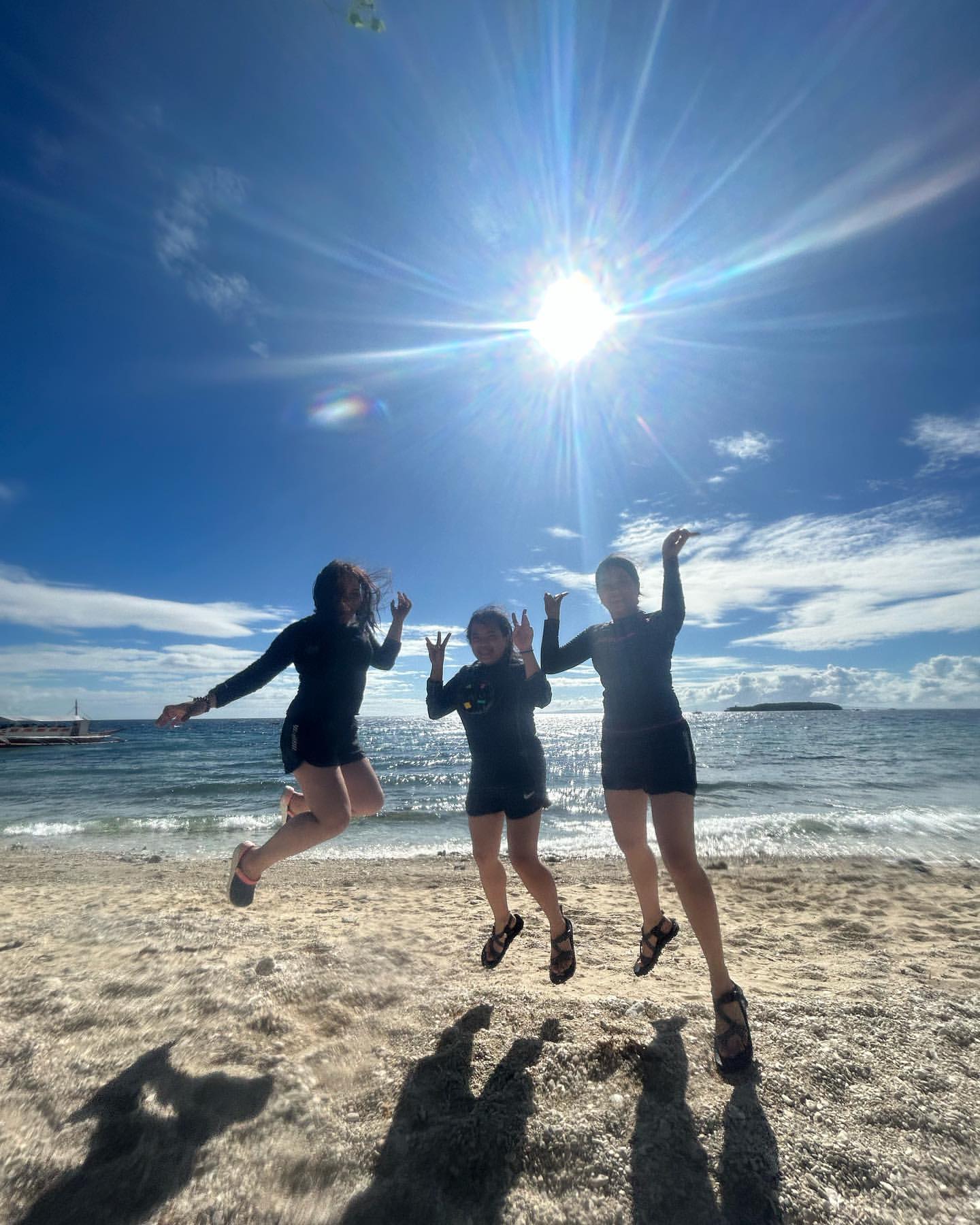
The waters are clear, the beaches are pristine, and there are many shaded areas to relax. Sumilon Island combines the excitement of Oslob with a relaxed island vibe.
Together, Tumalog Falls and Sumilon Island offer a peaceful experience that balances the excitement of swimming with whale sharks in Oslob.
Things to See Here
- Tumalog Falls
- Mossy Rock Walls (perfect for unique photos)
- Sumilon Sandbar (shifting white sand depending on the tide)
- Marine Sanctuary (snorkelling spot with corals and reef fish)
- Sumilon Lighthouse & Lagoon (quiet corners for exploration)
Useful Notes
- Opening Hours: Tumalog Falls- 6:00 AM to 5:00 PM, Sumilon Island- Day tours usually from 8:00 AM to 4:00 PM.
- Entry Fee: Tumalog Falls– 30 INR per person, Sumilon Island day tour– around 2360-3100 INR (includes boat, lunch, and access to resort facilities).
- Location: Oslob, Cebu (Tumalog Falls is 10-15 minutes from the whale shark site; Sumilon is a 15-minute boat ride away).
Travel Tip: Visit Tumalog Falls early to enjoy its tranquil setting, then head to Sumilon Sandbar before noon when the tide is low.
Experience the Sardine Run and Turtle Watching in Moalboal
Moalboal is a coastal town in southern Cebu. It is exclusively for divers. The sardine run is one of the most amazing underwater events in the world, which you must try.
Just a few meters from Panagsama Beach, millions of sardines swim together in sync, creating shimmering walls of silver under the water.
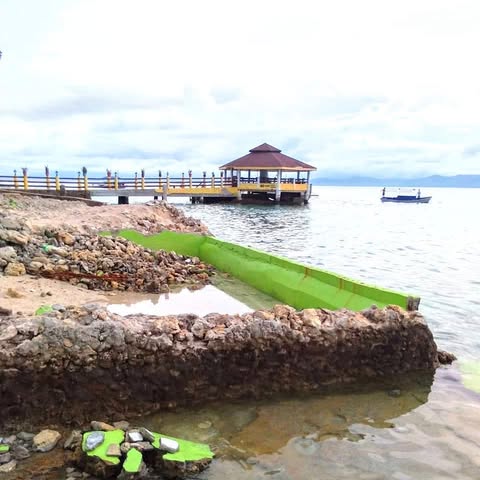
What makes it even better is that you don’t need scuba diving experience- snorkelling is enough to witness this natural phenomenon.
Alongside the sardines, Moalboal is also famous for turtle watching. Sea turtles can often be spotted grazing on seagrass or gliding gracefully through the reefs.
For those who want more, a short boat ride takes you to Pescador Island, a marine sanctuary known for colourful corals, reef fish, and occasional sightings of dolphins.
The combination of sardines, turtles, and rich coral life makes Moalboal one of Cebu’s must-visit spots for ocean lovers and underwater photographers.
Things to See Here
- Sardine Run (millions of sardines swimming in unison)
- Sea Turtles (easily spotted while snorkelling)
- Panagsama Beach (launch point for snorkelling and diving)
- Pescador Island (marine sanctuary with vibrant corals)
- Sunset by the Beach (Moalboal is known for fiery sunsets over the water)
Useful Notes
- Opening Hours: Snorkelling and diving tours run daily, best from 7:00 AM to 4:00 PM.
- Entry Fee: Sardine run is usually free (if snorkelling from shore); guided snorkel/diving trips to Pescador Island cost around 780-2330 INR.
- Location: Moalboal, Cebu (about 3 hours from Cebu City by bus or car).
- Recommended Duration: Half a day for snorkelling; full day if combined with Pescador Island.
Travel Tip: Bring your own snorkelling gear if possible- rentals are available, but personal gear is more comfortable and hygienic.
Go Island Hopping in Mactan and Nearby Islets
Cebu’s charm goes beyond the city; it includes the nearby islands. Mactan is the perfect starting point for island-hopping. You can enjoy white-sand beaches, clear waters, and lively marine life.
Just a short boat ride away, you can spend the day snorkelling, swimming, or simply lounging by the shore.
Popular stops include Hilutungan Island, famous for its marine sanctuary teeming with colourful fish and corals, and Nalusuan Island, where shallow waters make it ideal for families and beginner snorkellers.

Pandanon Island is another favourite, with its long sandbar and postcard-worthy views. Each island offers its own unique vibe, from lively snorkelling spots to quiet stretches of sand perfect for relaxation.
Most tours are guided, and packages often include fresh seafood lunches served right by the beach. It’s the perfect way to experience the tropical side of Cebu without straying too far from the city.
Things to See Here
- Hilutungan Marine Sanctuary (ideal for snorkelling)
- Nalusuan Island (shallow, clear waters)
- Pandanon Sandbar (stunning beach and sea views)
- Coral Reefs and Colourful Fish (snorkel spots all around)
- Beach Huts & Picnic Spots (perfect for a tropical lunch)
Useful Notes
- Tour Hours: Typically 8:00 AM- 4:00 PM
- Tour Cost: Around 3100-4600 INR per person (inclusive of boat, gear, guide, and meals)
- Location: Mactan Island, 30- 45 minutes from Cebu City
- Recommended Duration: Half-day to full-day trip
Travel Tip: Bring reef-safe sunscreen and a waterproof camera; you’ll want to capture both the underwater and the sandbar views.
Enjoy City Views from Tops Lookout and Temple of Leah
For a change of pace from Cebu’s islands and waterfalls, head up to the highlands of Busay, where sweeping city views and a touch of romance await.
Two of the most popular stops here are Tops Lookout and the Temple of Leah, both offering different yet equally memorable experiences.
Tops Lookout is on a hilltop that gives a view of Cebu City, Mactan, and even distant islands on a clear day. It is very popular at sunset when the skyline turns golden, and the city lights start to shine. The cool mountain breeze offers a refreshing break from the heat below.

Just nearby is the Temple of Leah, a grand Roman-inspired structure built in 2012 as a symbol of undying love.
The temple is inspired by ancient buildings and has tall columns, statues, and wide staircases. It is often compared to a small Parthenon. In addition to its impressive design, the temple provides great views of Cebu’s skyline, making it a popular photo spot for visitors.
Things to See Here
- Cebu City View (best at sunset)
- Open-Air Pavilion at Tops (perfect for relaxation and photos)
- Roman-Inspired Columns and Statues (at the Temple of Leah)
- Grand Staircases and Arches (ideal for photography)
- Cool Highland Breeze (a refreshing escape from the city heat)
Useful Notes
- Opening Hours: Tops Lookout- 6:00 AM to 11:00 PM; Temple of Leah- 7:00 AM to 6:00 PM
- Entry Fee: Tops Lookout- 160 INR; Temple of Leah- 160 INR
- Location: Busay, Cebu City (about 30 minutes by car from downtown)
- Recommended Duration: 1.5 to 2 hours (combine both spots in one visit)
Travel Tip: Visit in the late afternoon to catch both daylight views and the golden sunset, then stay a little longer to see Cebu come alive at night.
Feast on Cebu Lechon and Street Food
No trip to Cebu is complete without tasting its most famous dish- Lechon. Even Anthony Bourdain once called Cebu lechon the “best pig ever.” And once you’ve tried its crispy golden skin and tender, flavourful meat, you’ll understand why.
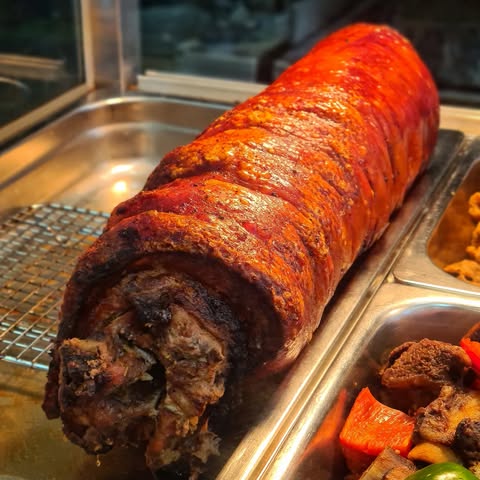
You can find lechon in almost every corner of the city, from big names like Rico’s and Zubuchon to local markets where it’s freshly roasted and served with puso (hanging rice wrapped in coconut leaves).
Beyond lechon, Cebu is also a paradise for street food lovers. From grilled skewers known as barbecue to sweet treats like masi (sticky rice balls with peanut filling), the city’s streets are alive with flavours.
To enjoy the Philippines’ nightlife, if you visit night markets such as Larsian BBQ or the Sugbo Mercado are where you’ll find locals and travellers alike digging into everything from siomai sa Tisa (famous Cebu-style dumplings) to mango shakes.
Whether you’re after a hearty plate of roasted lechon or a quick bite from a street stall, Cebu’s food scene is as much an adventure as its islands and waterfalls.
Things to Try Here
- Cebu Lechon (crispy, flavour-packed roasted pig)
- Puso Rice (hanging rice cooked in coconut leaves)
- Siomai sa Tisa (Cebu’s take on pork dumplings)
- Larsian BBQ (grilled skewers and local barbecue)
- Sugbo Mercado (street food night market with a wide variety)
Useful Notes
- Best Time: Lunch or dinner hours (lechon is usually freshest at midday)
- Average Cost: 230-650 INR per meal (lechon portions vary by serving)
- Locations: Rico’s Lechon, Zubuchon, Larsian BBQ, Sugbo Mercado Night Market
- Recommended Duration: 1-2 hours for a food crawl or dinner stop
Escape to Bantayan Island and Malapascua Island
If you’re craving a slower pace away from Cebu City’s crowd, two of the best escapes are Bantayan Island and Malapascua Island. Both are north of Cebu, and each offers a different kind of island magic.

- Bantayan Island is known for its wide, powdery white beaches and tranquil atmosphere. Life here is simple- cycling through sleepy fishing villages, visiting old churches, or lounging by the shore with fresh seafood. Kota Beach, in particular, is a favourite for its sandbar that stretches into turquoise waters, making it one of the most photographed spots on the island.
- Malapascua Island, on the other hand, is a diver’s paradise. It’s one of the few places in the world where you can reliably see thresher sharks year-round. Even if you’re not a diver, Malapascua charms visitors with its cosy beach resorts, colourful coral reefs for snorkelling, and a relaxed vibe that makes you forget about time.
Together, Bantayan and Malapascua show you a side of Cebu that’s unhurried, raw, and beautifully authentic.
Things to See Here
- Kota Beach Sandbar (Bantayan’s most iconic beach)
- Ogtong Cave Pool (a natural underground pool in Bantayan)
- Fresh Seafood Feasts (grilled squid, crabs, and more)
- Diving with Thresher Sharks (Malapascua’s signature experience)
- Coral Reefs & Snorkelling Spots (around both islands)
Useful Notes
- How to Get There: Bantayan- 4-5 hours by bus + ferry from Cebu City, Malapascua- 5-6 hours by bus + boat
- Entry Fee: None (standard diving/snorkelling tours cost 2350-6500 INR depending on activity)
- Recommended Duration: 2-3 days per island for a relaxed trip
Travel Tip: If time is short, pick one island. Bantayan for its beaches and chill vibe, and Malapascua for diving and marine life.
Conclusion
In this list of the best things to do in Cebu, we’ve managed to bring together the soul of the city, the thrill of adventure, the taste of tradition, and the calm of island life. From standing before Magellan’s Cross to leaping into turquoise canyons, from swimming alongside whale sharks to watching sunsets over the skyline, every experience here offers a different shade of Cebu’s personality.
This itinerary stands out because it offers a mix of experiences. You will enjoy history and adventure, great food and culture, as well as relaxing getaways and lively city life. You are not just seeing sights; you are making memories that will stay with you long after you are back.
So, whether you come for the stories, the food, the islands, or the adventures, Cebu will always find a way to surprise you. And to make your trip memorable, contact us as we bring your vacation dreams to life. Instead of just creating an itinerary and telling you how to spend your days, we work with you to customise your itinerary.
Frequently Asked Questions on Things to Do in Cebu
How many days do I need to explore Cebu?
Ideally, 4-5 days let you cover both the city highlights and nearby adventures like Kawasan Falls, Oslob, and Mactan. For Bantayan or Malapascua, add 2-3 extra days.
What is Cebu best known for?
Cebu is famous for its historic landmarks, island-hopping, canyoneering at Kawasan Falls, swimming with whale sharks, and, of course, Cebu lechon.
Is it safe to swim with whale sharks in Oslob?
Yes, it’s generally safe with guides and gear provided. Just remember to follow eco-friendly practices, no touching, no flash photography, and keep a safe distance.
When is the best time to visit Cebu?
The best time is from December to May when the weather is dry and perfect for island-hopping and outdoor adventures.
Is Cebu City walkable for tourists?
Downtown Cebu is walkable for visiting sites like Magellan’s Cross, Colon Street, and the Basilica, but for longer trips, taxis or ride-hailing apps are more convenient.